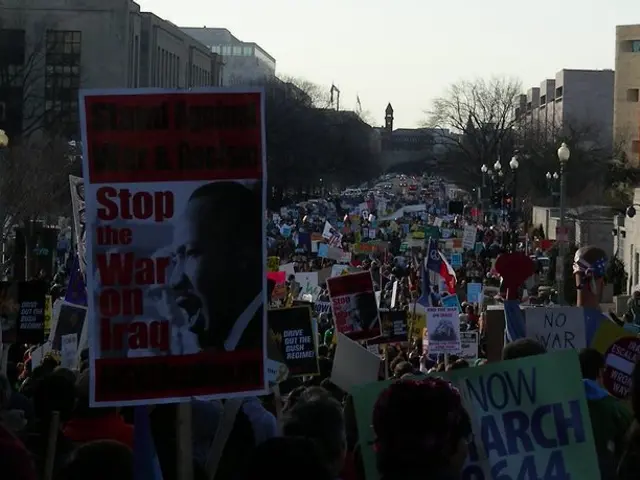Violence Erupts Among Buddhist Monks in Asia: Questioning the Abrupt Shift from Peace and Tranquility
A Fresh Perspective on the Conundrum of Buddhist Violence
Walk down the cobweb of global religious conflicts, and you'll find an intriguing twist - the serene Buddhism, often associated with peace, love, and non-violence, has a darker side prone to violent eruptions. This ironic facet of this much-loved faith is no longer a hidden puzzle to scholars and pundits, as the world witnesses an escalating global surge of religious violence.
In a world marked by religious upheaval, one might expect Buddhism to be exempt from the growing tide of extremism. But, as it turns out, the land of the Buddha is not immune to the dangers of religious favoritism and a corrupted relationship between temple and state.
The surprising story of Buddhist violence surges alongside a broader global resurgence of religion, echoing in the gasps of terror in the Middle East, India, Indonesia, Nigeria, Vietnam, the United States, and Europe. Engulfed in this chaos is a wave of a hate crime, predominantly against Jews and Muslims, revealing that religious violence is not exclusive to the developing world.
Yet, among the deluge of scholarly attention on religious violence, Buddhism remains an overlooked player. Despite its reputation as a bastion of peace, Buddhism has a rich and bloody history that belies the story of its non-violent teachings. The stereotype of Buddhism as a purely pacifist faith is a mere reflection of "positive Orientalism," a misguided fascination that assumes non-Western religions should be more committed to their original non-violent teachings than their Western Christian counterparts.
Pull back the layers of history, and Buddhist violence comes to light in surprising chapters:- Buddhist soldiers in sixth-century China were considered holy warriors for killing their enemies- Feudal Japan's Sohei, or warrior Buddhist monks, harassed territories and violently clashed with rivals- Sixteenth-century Thailand's holy men launched bloody revolts against the government- Jehovah's Witnesses and other non-Buddhist religious minorities faced persecution during Japan's militarist era, bolstered by Zen Buddhism- Buddhist monks participated in the chaos that unfolded in Tibet in 2008, leading to the death of dozens of people
Buddhist violence is no longer confined to countries where its community dominates - it has crept onto the world stage. Since the turn of the century, Buddhists have engaged in violence in eight of 11 countries where they comprise the largest religious group, and have even supported violence in countries where they are not the majority.
The 1995 deadly chemical weapons attack on the Tokyo subway system by the Japanese cult Aum Shinrikyo, with Buddhist roots, and the decades-long civil war in Sri Lanka, in which Buddhism played a key role, are scenes seared into global memory. Buddhist violence is also a component of an ongoing ethnic cleansing campaign in Myanmar and simmering conflicts in various parts of Asia.
Understanding why Buddhist violence erupts in some countries but not others has been the subject of scholarship, with much of the attention centered on its political and social context. While the entanglement between religion and state is a complex web that requires unraveling, our theory suggests that religious favoritism is a primary cause of majoritarian violence in Buddhist-majority countries.
To gain a deeper understanding of this phenomenon, we must delve into:
Political and Social Context
- The political bargain between Buddhism and the state, in which governments seek to exploit Buddhism's social prestige for political gain, often leading to the manipulation of Buddhist teachings and institutions to justify extreme nationalist or ethnic violence.
- Tensions between Buddhist communities and minority ethnic or religious groups, fueled by nationalist sentiments and the perceived threat to Buddhist identity or dominance.
Historical and Cultural Influences
- The historical connections between Buddhism and militarism, often serving as a tool for legitimizing political power.
- Cultural variations in the interpretation and application of Buddhist teachings across various regions, dictating different responses to violence.
Regional Specifics
- Myanmar: A prominent example of Buddhist violence is the conflict with the Rohingya Muslims, leading to significant violence and ethnic cleansing.
- Sri Lanka: The decades-long civil war was fueled by Buddhist nationalism, pitting majority Sinhalese Buddhists against the Tamil Hindu minority.
- Other Countries: Instances of Buddhist-influenced violence appear in countries like Japan, but are less common and less talked about.
- The wide-ranging subject of Buddhist violence extends beyond geographical boundaries, finding a presence in the heart of global research, academia, and general news.
- As ecologists delve deeper into the intricacies of human-environment interactions, they may find insights into the social and political factors that influence Buddhist violence.
- In the realm of tech innovation, data analysis and artificial intelligence could potentially predict and mitigate instances of Buddhist violence, shedding light on a solution to this persistent issue.
- With the intersection of politics and religion being a significant area of study for political scientists, unraveling the underlying causes of Buddhist violence can provide valuable insights into global affairs and diplomacy.








